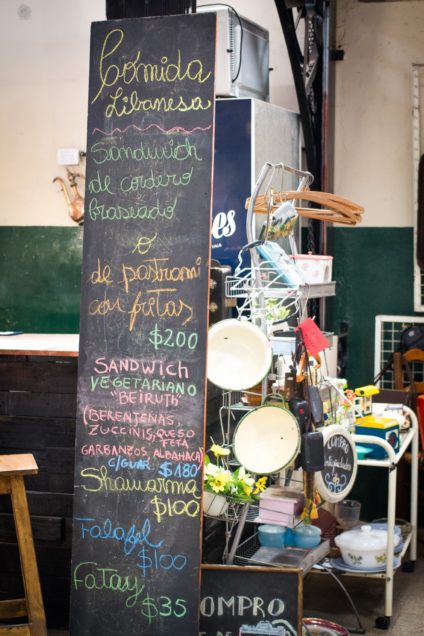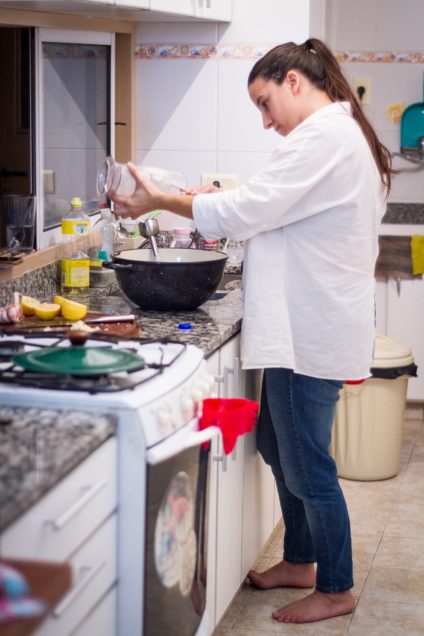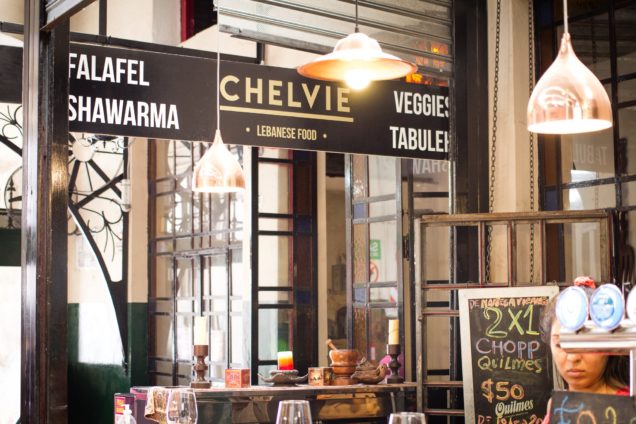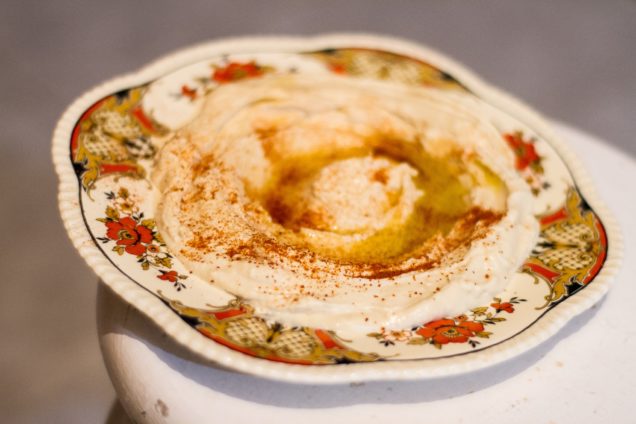Tiny Coffees and Food Fieldwork in Argentina
By Giselle Kennedy Lord
 It took me nearly 40 hours and a brand-new laptop to get to Buenos Aires to start my field research. As is my technological luck, my 6-year-old laptop decided to adopt toddler-like tendencies in starting up and shutting down two days before my departure. Sometimes it started up and sometimes it didn’t – no logical explanation for either. It stopped starting up at all while I was on the first leg of my journey to Argentina, which is not a place where you can buy or repair technology in any sort of economical or reasonable way. But I had to get on that plane, and in the end, I boarded that plane carrying a brand-new laptop still wrapped and in its box from the Apple store in Manhattan where I purchased it on a credit card during my 15-hour layover.
It took me nearly 40 hours and a brand-new laptop to get to Buenos Aires to start my field research. As is my technological luck, my 6-year-old laptop decided to adopt toddler-like tendencies in starting up and shutting down two days before my departure. Sometimes it started up and sometimes it didn’t – no logical explanation for either. It stopped starting up at all while I was on the first leg of my journey to Argentina, which is not a place where you can buy or repair technology in any sort of economical or reasonable way. But I had to get on that plane, and in the end, I boarded that plane carrying a brand-new laptop still wrapped and in its box from the Apple store in Manhattan where I purchased it on a credit card during my 15-hour layover.
Before beginning this research, my advisor recommended that I formulate a very solid plan and then expect the unexpected, to let the research become what it was going to be and learn to essentially roll with the punches if things didn’t happen as planned. This proved to be very useful advice at many turns along the way. My mantra during my six weeks in Argentina is a phrase I learned the first time I went there twelve years ago: con la fuerza. (The literal translation of this is “with the force,” but it has absolutely nothing to do with Star Wars and its meaning lies as much in how you say it as in what is being said.)
I arrived in Buenos Aires after two nights of sleeping on planes. I spent most of my time there based in Palermo – a vibrant, progressive neighborhood and arguably the gastronomic center of the city. In the beginning, I spent a lot of time in hip cafes drinking tiny coffees and eating tiny croissants while reading research on the Lebanese diaspora in Latin America, particularly research related to food culture. But I had already been reading this research for a few months and was eager to make some real-life connections now that I was in Argentina. I was also pretty nervous about whether or not I would be successful making those connections. In terms of field research, this was definitely my first rodeo.
My thesis research centers around food in diaspora, specifically the food culture of Lebanese people and families living in Latin America. My goal is to examine and better understand the way in which these families and individuals use food as a way to connect to their roots and establish identity, or if they even do at all. There are huge populations of Middle Eastern people living in Latin America, particularly in Brazil and Argentina. It is my belief that the landscape and eating habits of these two far-flung regions of the world are quite complimentary if not also somewhat similar in certain places. But it’s people who perpetuate, leave behind, reinvent, and recontextualize food practices, traditions, and products, and it is my goal to discover how that pans out in Argentina and Latin America in the kitchens of the Lebanese. The grand majority of Lebanese immigrants in Argentina arrived in the late 1800s and early 1900s but, while research on these migrant populations is (thankfully) growing, there is a relative lack of research in the frame of food. But I have qualitative evidence that Lebanese food is a most tenacious tradition, even across continents and generations.
Since I arrived in Buenos Aires not knowing any Lebanese people there, I didn’t have ample time to pull off the 15-20 interviews at-home I had proposed. (I think I could get that and more now that I’ve cultivated those connections and relationships, an integral part of ethnographic research that must be done without a formula or rulebook). I did, however, return home about a month ago with five deep, dynamic interviews and case studies from the Lebanese people I got to know and spent time with in Buenos Aires. I have six weeks of notes and observations on Middle Eastern and Lebanese food in the capital city of the country occupied by the third largest population of Lebanese people outside of Lebanon. I have thirty surveys filled out by Lebanese people in different countries throughout Latin America. I have a stack of menus from Middle Eastern restaurants, many gigabytes of photos, and a whole new perspective on my own identity as the daughter of a Lebanese immigrant (raised on kibbi, much like all my participants). In the end, the research began to take shape and I learned to bend and expand my own approach and perspective along the way. I spent more time with the five people I did come to know and used much of my other time gathering data and making observations that I knew I’d only be able to glean while I was on the ground there.
 Contrary to what seems like a universal dependence on e-mail for making a connection, knocking on a door in Argentina will get you much farther if you’re looking to shake a hand and talk about hummus. I met Mari and Rosanna at La Iglesia de San Marón just in time to spend a day with them preparing food for a 200-person celebration in honor of the more-than-a-century-old church’s patron saint that coming Sunday. I gained invaluable perspective on how and why non-Lebanese Argentines learned to cook Lebanese food, the symbolism of group consumption, and notions of collective identity. That Sunday, while munching on the mini mana’eesh I’d spread za’atar on the day before, I met Aida, a spritely 86-year-old woman who would invite me to her home to eat lunch, prepare kibbi, and tell me her story. In Aida’s kitchen, I took careful note of the way her story tied to her food traditions and how her Lebanese and Argentine heritage come together at her table. I greeted Sergio Jalil, who I had met a few days earlier (by simply showing up at his office) and who is the founder and executive director of CELIBAL, a non-political organization whose mission it is to expose and represent an inclusive identity for Lebanese people in Latin America and to provide their community with a forum to talk about their unique identity. Sergio and his wife, Marianela, invited me to their home for a Lebanese dinner and a conversation about their families, their history together, and their favorite dishes. In their home, I came upon that tenacity of the tradition I mentioned earlier, confronted the results of class differences within the community, and caught a glimpse of the social manifestations of Lebanese identity-building in Argentina.
Contrary to what seems like a universal dependence on e-mail for making a connection, knocking on a door in Argentina will get you much farther if you’re looking to shake a hand and talk about hummus. I met Mari and Rosanna at La Iglesia de San Marón just in time to spend a day with them preparing food for a 200-person celebration in honor of the more-than-a-century-old church’s patron saint that coming Sunday. I gained invaluable perspective on how and why non-Lebanese Argentines learned to cook Lebanese food, the symbolism of group consumption, and notions of collective identity. That Sunday, while munching on the mini mana’eesh I’d spread za’atar on the day before, I met Aida, a spritely 86-year-old woman who would invite me to her home to eat lunch, prepare kibbi, and tell me her story. In Aida’s kitchen, I took careful note of the way her story tied to her food traditions and how her Lebanese and Argentine heritage come together at her table. I greeted Sergio Jalil, who I had met a few days earlier (by simply showing up at his office) and who is the founder and executive director of CELIBAL, a non-political organization whose mission it is to expose and represent an inclusive identity for Lebanese people in Latin America and to provide their community with a forum to talk about their unique identity. Sergio and his wife, Marianela, invited me to their home for a Lebanese dinner and a conversation about their families, their history together, and their favorite dishes. In their home, I came upon that tenacity of the tradition I mentioned earlier, confronted the results of class differences within the community, and caught a glimpse of the social manifestations of Lebanese identity-building in Argentina.
Though I hadn’t intended to look much at restaurants, at that point I could not deny the importance of exploring and understanding the restaurant culture of Lebanese and Middle Eastern food in Buenos Aires, if only to relate it to food practices at home. What I found was surprising to say the least – a plethora of restaurants identified as comida arabe with strikingly similar menus and only three restaurants that specifically identify as Lebanese. Analyzing the menus of these restaurants brings to light what foods have been deemed acceptable and appealing in the particular gastronomic and cultural landscape of Buenos Aires, the difference between what is cooked at home and what is cooked for public consumption, and the way specific foods and dishes have been recontextualized, hybridized, and changed. I spent plenty of time taking (sometimes edible) notes on other popular restaurants and cuisines in Buenos Aires, to build a framework for understanding Lebanese food from the broader perspective of international food in the metropolitan city. Not surprisingly, my observations of the restaurant scene there resulted in meaningful research and memorable meals. It also led me to Diego and Mariana.
 I went to the historic Mercado de San Telmo for a meal at a Lebanese restaurant/fancy food stall called Chelvie. Diego and his brother, Alejandro, opened Chelvie just last Fall and it fits perfectly in the market, which was once a place for antique and grocery shopping and, though the antique stalls and a few of the food vendors are holding strong, has become a veritable international food market, with food stalls and restaurants offering Swiss, French, Spanish, Mexican, Vietnamese, and, of course, Argentine fare. The Chelvie menu is unlike any other Middle Eastern menu I came across in Buenos Aires. Diego told me it was inspired by the typical dishes of an assortment of different members of his family. Diego kept returning to the idea that they’d opened the restaurant ‘for his family,’ something that came up often in talking to my participants about their food. Homage was emerging as a common theme and was a motivation for business and sentiment that Mariana also described while we ate hummus in her backyard.
I went to the historic Mercado de San Telmo for a meal at a Lebanese restaurant/fancy food stall called Chelvie. Diego and his brother, Alejandro, opened Chelvie just last Fall and it fits perfectly in the market, which was once a place for antique and grocery shopping and, though the antique stalls and a few of the food vendors are holding strong, has become a veritable international food market, with food stalls and restaurants offering Swiss, French, Spanish, Mexican, Vietnamese, and, of course, Argentine fare. The Chelvie menu is unlike any other Middle Eastern menu I came across in Buenos Aires. Diego told me it was inspired by the typical dishes of an assortment of different members of his family. Diego kept returning to the idea that they’d opened the restaurant ‘for his family,’ something that came up often in talking to my participants about their food. Homage was emerging as a common theme and was a motivation for business and sentiment that Mariana also described while we ate hummus in her backyard.
Mariana’s grandfather is Lebanese and she grew up well steeped in Lebanese food culture – their own unique brand of culinary knowledge and practice passed down from his mother to his wife and eventually to Mariana. Mariana, called Berta by close friends, is the youngest of my participants and recently started a business of making, selling, and delivering her well-tested and totally delicious hummus to people in and around Buenos Aires. Hummus delivery. I know, I want that in my town too. When I asked Mariana why, her rather poetic answer was all about family, just like Diego. (She had also been inspired by the popular, overly varied, oddly flavored, packaged hummus she’d discovered during a trip to New York. But she mostly holds true to her fantastic recipe for classic hummus of which her grandfather would be proud.) In Diego and Mariana, I found the crossroads between home and entrepreneurship, heart and duty, memory and making a living. I also came to realize that gender concepts were not shaking out the way I’d expected but the emotions and memories my participants attached to food were pretty darn consistent.
Sergio helped me get an online survey out to the CELIBAL community and I’ve got about thirty completed surveys that I can’t wait to analyze. I can’t wait to discover the nuances, differences, commonalities, and surprises that I’m sure lie within. I’d love to continue getting responses to that survey, I’d love to keep interviewing and cooking with people, but alas I am switching into writing mode. My first conclusion is that I am only scratching the surface on this topic.
My field research in Argentina was an invigorating, challenging, surprising, and fulfilling experience. I learned so much about research, about people, about myself, and about empandas arabes. Overall, I’d say I did what I went there to do. I got some very juicy material and enough of it to write a great paper, if I play my cards right (i.e. staying in this seat and typing on beautiful summer days). But now the new ‘real work’ begins. I’ve got to get all this data on the same wavelength, establish my themes, provide my evidence, make some qualitative conclusions, and tell these stories. There are moments when it seems impossible that all these notes in all these notebooks and word documents and margins of research papers will come together to form a righteous examination of this topic that I’ve spent so much time thinking about. And there are moments, as I begin to work through and transcribe and translate and analyze all those notes, that it becomes very clear that it would be impossible not to see the feast of a story all these little pieces will make when they’re put together. Con la fuerza.